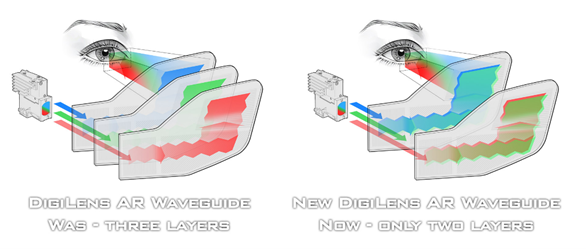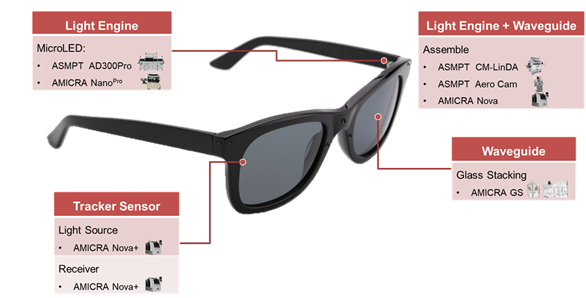The metaverse gold rush has prompted big companies to seize new opportunities in this new digital landscape. In the second half of the year, Meta will roll out its advanced VR glasses, the Quest 2 Pro; ByteDance will ramp up its marketing efforts in China following the acquisition of Pico, a VR company, while Apple and Sony will each release new headsets which will capture certain market shares in 2023. It goes without saying that an “Augmented and Virtual Reality War” is about to kick off. Anyone who masters the must-have technologies will be the first to win a ticket to the metaverse world.
As TrendForce’s Q2 report reveals, global shipments of AR/VR devices will total 13.85 million units this year, up 40.5% from the year before, with Microsoft’s HoloLens 2 and Meta’s Oculus Quest 2 capturing the largest share in the AR and VR markets, respectively.
Mr. CT Lau, senior business development manager at ASMPT Limited (ASMPT), indicated that there are various “doors” to the metaverse such as 5G or 6G processors, semiconductors, battery life, sensors, and technical development components, among which display technologies are the most crucial elements. Accordingly, ASMPT has partnered with major players to develop new technologies, aiming to transform these elements into the key to the metaverse.
The Key to VR Has Formed, while More Time Is Needed for AR
The metaverse frenzy will accelerate the development of AR/VR headsets among suppliers, stimulating growth in the headset industry. The metaverse development trends can be divided into VR (virtual reality) and AR/MR (augmented reality/mixed reality). Specifically, VR glasses can capture human motions using cameras or infrared sensors with more mature technologies compared to VR/MR devices.
Overall, most suppliers can manufacture VR components because of more mature technologies. According to Lau, ASMPT’s packaging equipment has met the requirements of VR semiconductor components, including technologies related to power management ICs, MCUs, RF communication, MEMS and sensors, memories, and cameras. Currently, there are numerous ASMPT-made VR components in the market.
(Credit: ASMPT)
AR Glasses Focus on Light Weight and Die-Stacking Design
Unlike VR technologies, more time is needed for AR devices to mature.
Ideally, AR glasses must have high brightness, high resolution, and be light weight to operate smoothly under the ambient light so that they will not cause discomfort to the wearer. Therefore, the development of displays and optical systems is critical.
Most AR glasses work by projecting images onto the lens using Micro LED, Micro OLED or LBS light engines. Because Micro LED outperforms other technologies in terms of contrast, responsiveness, lifetime and energy efficiency, it can be the most preferable technology for AR development in the long run.
(Credit: ASMPT; image samples from left to right: TriLite, CEA-Leti, Jade Bird Display)
Lau suggested that ASMPT encountered various challenges when developing Micro LED transfer and bonding solutions as AR glasses—with limited space—require the use of <5µm Micro LED chips to achieve high resolution. Thanks to its strong research and development capabilities and Micro LED package patents, the company was ultimately able to overcome difficulties by mass transferring RGB Micro LEDs and bonding them to the target light engine.
Optical waveguide is another vital technology enabling AR glasses to guide images from the edge of the lens to the center. When stacking waveguides, manufacturers must pay attention to the accuracy of mirror image projection while ensuring thin and light design, making the production process more difficult. To overcome the said difficulties, ASMPT partnered with major AR businesses and developed waveguide stacking machines featuring accurate epoxy, stacking and curing of two to three dies at one time, thereby meeting the mass production standard.
(Credit: DigiLens)
As Lau specified, at least 80% of all the existing Micro LED products were made using ASMPT’s patented packaging equipment. Regarding light source assembly, subsequent integrated services, and new technologies necessary for AR devices, the equipment maker partnered with relevant suppliers to develop CMOS image sensors, micro eye tracker technologies and ultra-mini cameras, aiming to improve tracking and positioning accuracy of eye movements and gestures. “The metaverse is rising quickly and is becoming part of our everyday life; it will experience widespread use in the near future. ASMPT has been working with leading companies to develop critical packaging processes. Particularly, its new technologies such as those for light engines and waveguide processing provide comprehensive solutions that can accelerate the progress of product market entry,” Lau said confidently.
(Credit: ASMPT)
Get Ready for the Metaverse Boom in 3 Years
TrendForce predicts that the market value of Micro LEDs for AR glasses displays will hit US$41 million in 2026. As technologies for red chip fabrication, laser transfer, wafer bonding and full-color display are expected to mature between 2025 and 2026, the yield rate of Micro LEDs is likely to reduce with a lower production cost, thereby boosting the market value.
Following technological maturity, Micro LED AR glasses for the metaverse will be first applied to specific sectors such as medical surgery and test equipment, factory environmental monitoring and repair tools, and military purposes. After further technological advances are achieved and the cost becomes low enough for commercialization, such eyewear will likely be seen in consumer full-color display applications.
However, Lau believes the metaverse market and AR applications will not mature within the next 2 to 3 years, while costs, mass production readiness, and application design will become major concerns. Despite the uncertainty over product pricing, future applications will become clearer if Apple manages to roll out its headset in 2023 as scheduled. Meanwhile, as suppliers have been improving their products and technologies, it is possible that users will be able to create their own virtual world in the near future.















